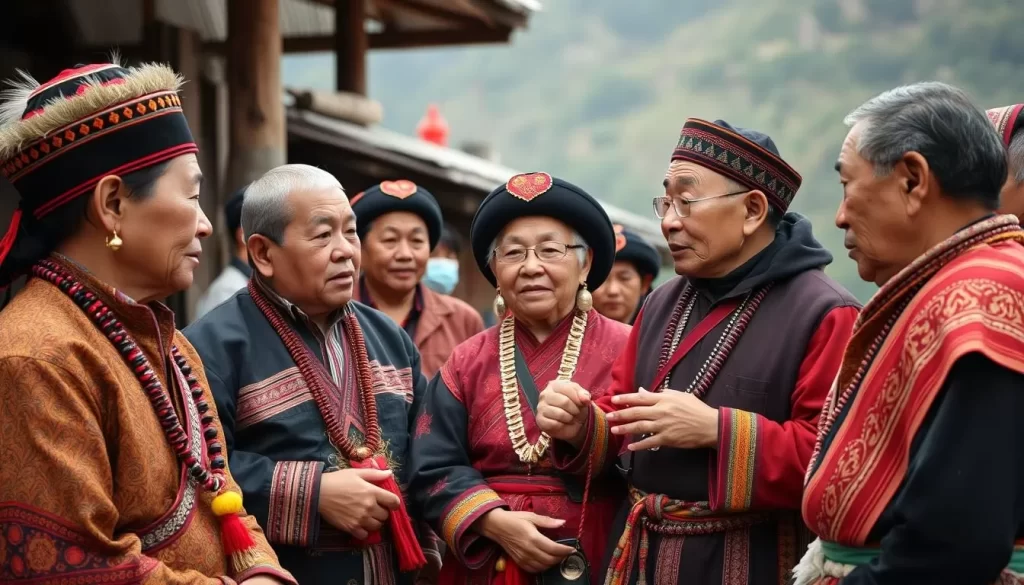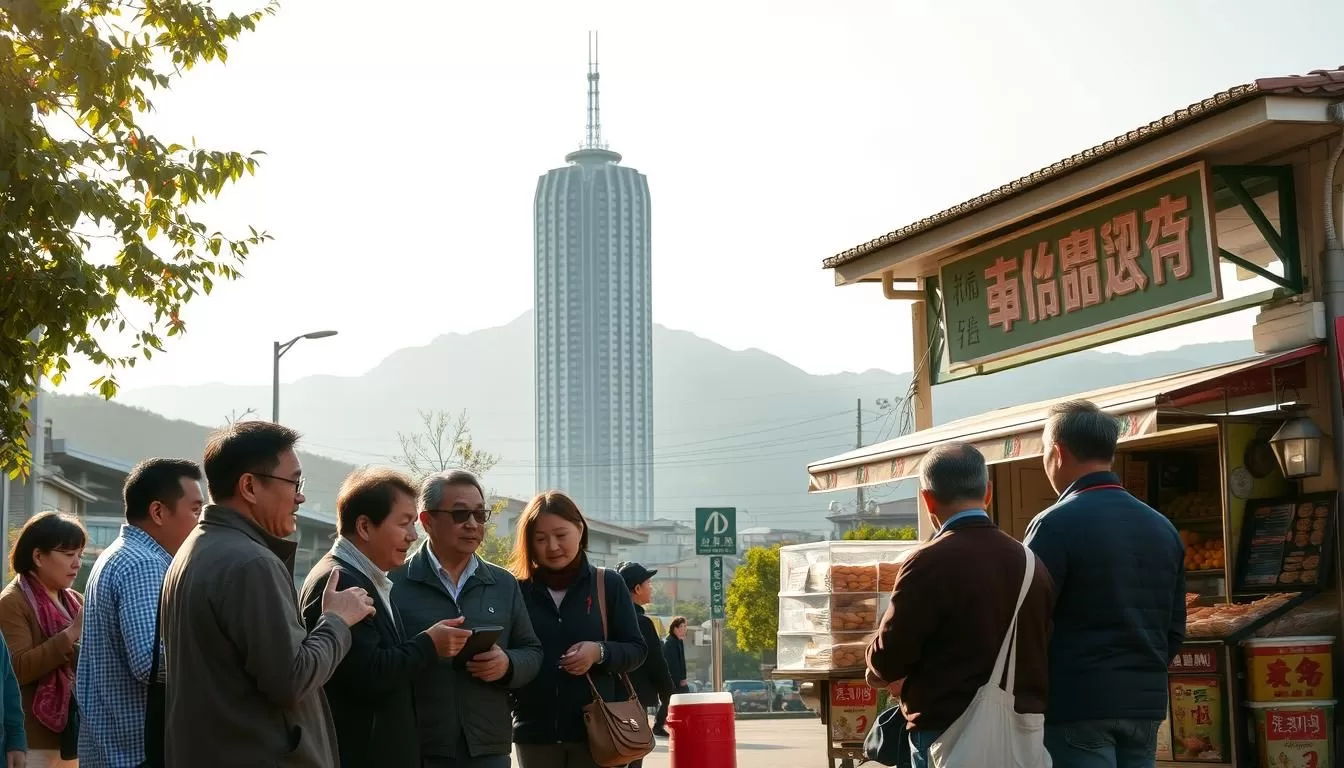✓ Accommodations✓ Flights✓ Rental Cars
As you explore Nantou County in central Taiwan, you’ll discover a rich tapestry of languages that reflect the island’s complex cultural history and diverse population.
The linguistic landscape in this mountainous region is characterized by multiple languages being spoken, with Mandarin Chinese serving as the official language.
However, you’ll also encounter Taiwanese Hokkien, Hakka dialects, and indigenous Formosan languages that have been spoken on the island for thousands of years.
Understanding the language situation in Nantou County will enhance your travel experience, allowing you to better appreciate the cultural nuances and historical context of this fascinating region.
Language Landscape of Nantou County

As you explore Nantou County, you’ll discover a unique blend of languages spoken across the region. Nantou County sits at the geographical heart of Taiwan, making it a unique crossroads where various linguistic communities have converged throughout history.
Nantou’s population of approximately 500,000 people represents Taiwan’s linguistic diversity in microcosm, with speakers of multiple languages coexisting in both urban centers and rural villages. The county’s position as home to Sun Moon Lake and several indigenous tribes has created linguistic pockets where you can still hear Formosan languages being spoken in everyday contexts.
The mountainous geography of Nantou has played a crucial role in language preservation, as isolated communities in areas like Cingjing and Renai Township have maintained distinct linguistic traditions. When traveling through Nantou County, you’ll notice that language distribution follows certain geographical patterns – Mandarin is universally understood, while Taiwanese Hokkien is more common in market towns and rural areas.
Nantou’s language landscape reflects broader patterns in Taiwan, where approximately 83.5% of people speak Mandarin, 81.9% speak Taiwanese Hokkien, 6.6% speak Hakka, and smaller percentages speak indigenous languages in their homes. This diversity is a testament to Taiwan’s rich cultural heritage and the complex history of language use in the region.
Mandarin Chinese: The Official Language
As the official language of Taiwan, Mandarin Chinese plays a vital role in Nantou County’s daily life and formal communications. Introduced as the national language in 1945, following the end of World War II, Mandarin Chinese has become the lingua franca among various ethnic groups in Taiwan.
In Nantou County, as throughout Taiwan, Mandarin Chinese serves as the official language and is used in all government functions, educational settings, and formal communications. You’ll notice that nearly everyone speaks Mandarin Chinese, though the variant spoken here, known as Taiwanese Mandarin, has distinct characteristics that differentiate it from Beijing Mandarin.
One of the key differences between Taiwanese Mandarin and Beijing Mandarin is the use of traditional Chinese characters in writing. Unlike mainland China, which uses simplified Chinese characters, Taiwan exclusively uses traditional characters, preserving more of the historical elements and complexity of the original characters.
When interacting with locals in Nantou, you might notice subtle differences between Taiwanese Mandarin and Beijing Mandarin, including unique vocabulary items, different pronunciation patterns, and the influence of other local languages. For instance, Taiwanese Mandarin features a softer pronunciation of certain consonants and incorporates loanwords from Japanese and Taiwanese Hokkien.
| Characteristics | Taiwanese Mandarin | Beijing Mandarin |
|---|---|---|
| Chinese Characters | Traditional | Simplified |
| Pronunciation | Softer consonants | Standard pronunciation |
| Vocabulary | Includes loanwords from Japanese and Hokkien | Standard Mandarin vocabulary |
Understanding these nuances can enhance your experience in Nantou County, allowing you to appreciate the unique cultural and linguistic heritage of the region.
Taiwanese Hokkien in Nantou County
As you explore Nantou County, you’ll notice that Taiwanese Hokkien is an integral part of the local culture. Taiwanese Hokkien, often simply called ‘Taiwanese,’ is the most-spoken native language in Taiwan, used by about 70% of the population.

Taiwanese Hokkien is widely spoken throughout Nantou County, particularly in markets, small businesses, and homes, serving as the mother tongue for many residents. The dialect has regional accent variations, with subtle differences between the northern and southern parts of the county.
- The Hokkien spoken in Nantou County traces its origins to Fujian Province in southern China, creating a linguistic connection that spans the Taiwan Strait.
- When visiting traditional markets in Nantou City or Puli, you’ll likely hear vendors and customers conversing in Hokkien, as it remains the preferred language for informal commercial interactions and everyday conversation.
- Generational differences in Hokkien proficiency are noticeable among Nantou residents; older generations tend to be more fluent, while younger people may understand but speak with less confidence.
The Taiwanese Hokkien spoken in Nantou contains numerous loanwords from Japanese, a linguistic legacy of Taiwan’s colonial period. In recent years, there have been increasing efforts to preserve Taiwanese Hokkien, including language classes in schools and cultural events celebrating the language.
Understanding the significance of Taiwanese Hokkien in Nantou County provides insight into the county’s cultural identity and the importance of preserving linguistic diversity. As you engage with the local community, you’ll appreciate the role that Hokkien language plays in shaping the social fabric of the region.
Hakka Language Communities
As you explore Nantou County, you’ll discover the rich cultural heritage of the Hakka language, known as (Hak-kâ-ngî). Although Hakka communities in Nantou are smaller compared to neighboring counties like Miaoli, significant Hakka-speaking populations can be found in specific townships, particularly in the western parts of the county.
When visiting these Hakka communities, you’ll encounter different subdialects of the language, with Sixian and Hailu being the most commonly spoken variants among local Hakka residents. The Hakka language holds tremendous cultural significance for its speakers in Nantou, serving as a carrier of unique traditions, folk songs, and culinary practices that distinguish Hakka culture.
Despite government recognition and preservation efforts, the vitality of the Hakka language faces challenges in Nantou County, with younger generations increasingly shifting to Mandarin for daily communication. However, local initiatives aimed at promoting the language and culture are underway, including cultural festivals, language classes, and community centers dedicated to preserving this important piece of Taiwan’s linguistic heritage.
The population that speaks Hakka in Nantou, though smaller than in Taiwan’s northern counties, maintains strong cultural ties through language preservation efforts, with many families still speaking Hakka at home despite the dominance of Mandarin in public settings. This reflects the importance of the Hakka language in maintaining the community’s identity and cultural heritage.
Indigenous Formosan Languages of Nantou County

As you explore Nantou County, you’ll discover the diverse indigenous Formosan languages spoken there. The Taiwanese indigenous peoples, comprising about 2.3% of the island’s population, have a rich linguistic heritage. However, after centuries of language shift, far fewer can still speak their ancestral language.
Nantou County is home to several indigenous tribes, including the Bunun, Atayal, and Seediq peoples, who have significant populations in the mountainous eastern regions. When visiting these communities, you’ll find that the current status of native languages varies widely. Some villages maintain strong language transmission, while others are witnessing rapid language shift toward Mandarin.
Numerous language revitalization efforts are underway throughout Nantou’s indigenous communities. These include immersion programs, cultural camps, and elder-youth language partnerships designed to preserve these endangered languages. The indigenous languages of Nantou County hold immense cultural importance, containing unique knowledge systems about local ecology, traditional medicine, and spiritual practices that cannot be fully translated into Chinese languages.
During your travels in Nantou, you might encounter educational programs in indigenous areas where children are learning their ancestral languages alongside Mandarin. This is part of Taiwan’s broader effort to preserve its linguistic diversity. The Formosan languages spoken in Nantou are of special significance to linguists worldwide, as Taiwan is considered the homeland of the entire Austronesian language family.
When interacting with indigenous communities in Nantou, you’ll gain appreciation for how language preservation connects directly to cultural identity and sovereignty for these groups who have inhabited the island for thousands of years.
Nantou County, Taiwan: Official and Widely Spoken Languages in Historical Context
Understanding the linguistic landscape of Nantou County requires a dive into its complex history. The region’s language profile has been shaped by various historical events, including the Japanese occupation period from 1895 to 1945.
During your travels in Nantou, you’ll notice Japanese linguistic influences everywhere, from place names to loanwords that have been incorporated into local languages, especially in areas related to infrastructure, food, and household items. This legacy of the Japanese era continues to be evident in the language spoken today.

The language policies implemented during Taiwan’s Martial Law era (1949-1987) had a significant impact on Nantou’s linguistic diversity. The government actively suppressed non-Mandarin languages in schools and public institutions, which damaged the evolution of local languages, including Taiwanese Hokkien, Hakka, and Formosan languages.
Many older residents in Nantou who grew up during the Martial Law period have complicated relationships with language, having been punished in school for speaking their mother tongues instead of Mandarin. However, since the 2000s, the government has made efforts to protect and revitalize local languages, introducing them into elementary school education and establishing public TV and radio stations exclusively for these languages.
The evolution of language attitudes in Nantou County reflects broader changes in Taiwanese society, shifting from suppression of local languages to active preservation efforts today. Historical events like the 228 Incident and subsequent White Terror period created linguistic divides in Nantou that still resonate today, with language choice sometimes reflecting political and identity positions.
When conversing with locals in Nantou, you might notice how historical circumstances have created a unique linguistic situation where many people code-switch between languages depending on context, topic, and the age of the person they’re speaking with. This complex linguistic landscape is a testament to the region’s rich history and cultural diversity.
English and Other Foreign Languages in Nantou County
The language landscape of Nantou County is evolving, with a particular focus on English and other foreign languages. As a result, people in Nantou are becoming more proficient in communicating with the world beyond Taiwan.
In Nantou County, English education is emphasized in schools, with students beginning their English studies in elementary school and continuing throughout their education. You’ll notice varying levels of English proficiency among different age groups – younger people generally have better English skills than older generations.

Tourism has significantly influenced foreign language use in Nantou County, with popular destinations like Sun Moon Lake featuring signage and services in English, Japanese, and Korean to accommodate international visitors. During your visit, you might encounter languages from Southeast Asia like Indonesian, Vietnamese, and Thai, spoken by migrant workers and spouses.
As you travel through Nantou, you’ll discover that the county’s growing international connections have created increasing opportunities for locals to learn foreign languages. While English is the most widely studied foreign language, Japanese maintains a special status due to historical connections and tourism.
Practical Language Tips for Visitors to Nantou County
Knowing a few key phrases in Mandarin Chinese can go a long way in making your visit to Nantou County memorable. As you explore this linguistically diverse region, you’ll find that language plays a significant role in shaping the local culture.
When visiting Nantou County, you’ll encounter different languages in various contexts. Mandarin Chinese is universally understood, while Taiwanese Hokkien is common in markets and rural areas. Indigenous languages might be heard in eastern mountain communities.
To navigate language barriers, consider using language resources like translation apps, pocket dictionaries, and picture guides. Understanding cultural etiquette related to language use is also important, such as addressing older people with appropriate honorifics.
Today, Nantou County represents a fascinating linguistic microcosm of Taiwan, where you can experience the country’s rich language heritage. By learning a few essential phrases, you can enhance your travel experience and show respect for the local culture in a meaningful way.
The above is subject to change.
Check back often to TRAVEL.COM for the latest travel tips and deals.






